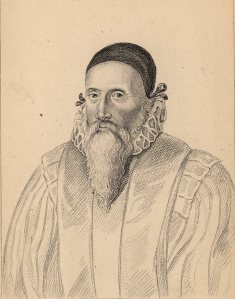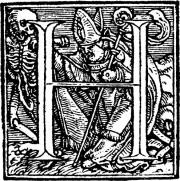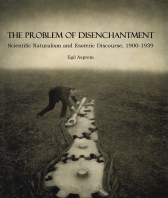 A couple of weeks ago I promised to take a closer look at one of the articles from the present issue of Aries. Now I finally found an occasion to look at James Justin Sledge’s contribution, “Between Loagaeth and Cosening: Towards an Etiology of John Dee’s Spirit Diaries”. As the title suggests, it’s about the Elizabethan philosopher, mathematician and magus John Dee’s famous conversations with angels, and his favourite skryer, Edward Kelly.
A couple of weeks ago I promised to take a closer look at one of the articles from the present issue of Aries. Now I finally found an occasion to look at James Justin Sledge’s contribution, “Between Loagaeth and Cosening: Towards an Etiology of John Dee’s Spirit Diaries”. As the title suggests, it’s about the Elizabethan philosopher, mathematician and magus John Dee’s famous conversations with angels, and his favourite skryer, Edward Kelly.
Historians’ knowledge about these sessions, in which John Dee (1527-1608/9), together with various “skryers”, would attempt to communicate with angels through a crystal, comes primarily from diaries which were kept over the years 1581-1587. In this period Dee worked with Edward Kelly/Talbot (1555-1597), his most successful skryer. Original sources are preserved in the British Library, and the Ashmolean collection in Oxford (scans of the former are even available online here). Another and far more lasting impact of historians’ understanding of these angelic conferences is Meric Casaubon’s True and Faithful Relation, published in 1659 out of the expressed intention to debunk Kelly as a sinister necromancer, and Dee as duped.
There is now a rather abundant literature on Dee and the angel conversations. Sledge’s contribution is nevertheless novel in that it asks questions which are usually bracketed by historians: What was really going on in those sessions? How do we explain Kelly’s claimed visions, and the seemingly “supernatural” goings-on connected with the events?
It is in fact rather striking that the large literature on the subject mostly avoids these questions, either by explicit bracketing or implicitly by offering extremely vague suggestions. Quotations drawn from several of the recent scholars who have looked at the Dee diaries – Deborah Harkness, Håkan Håkansson, Nicholas Clulee, György E. Szőnyi – exemplify these traits (p. 7, n. 19).
Nevertheless, there have been theories and hypotheses. Sledge discusses three classes of”etiological theories” that have been raised:
1) The “supernaturalistic” thesis that Dee/Kelly were, in fact, in contact with super-human entities (or other “hidden” or unverifiable aspects of reality – Sledge actually groups the various psychoanalytic accounts, from Freud to Jung to Lacan under the same heading, as relying on untestable assumptions and philosophic systems which themselves have to be accounted for in order to have any explanatory value) ;
2) The Kelley-as-charlatan theory, claiming that Kelly relied on trickery, legerdemain, subterfuge, lies, fraud and manipulation in order to get what he wanted out of the naive philosopher. On this account, Kelly fabricated the visions and artifacts associated with the actions for personal material gain.
3) The “altered states of consciousness”(ASC)-theory, stating that Kelly “genuinely had phenomenological experiences, covered by material explanations, which are recorded in the spirit diaries” (p. 10).
The author defends a version of the third etiological type, but stresses that it does not rule out the hypothesis of fraud for at least some of the instances.
Furthermore, Sledge is unsatisfied with the way in which ASC-theories have been presented in earlier works, typically in the form of “Kelly was deranged”/”Kelly was in trance” – statements which both lack any real explanatory power as long as they remain vague, undefined and untheorised. The article mitigates some of these quite common faults by offering a rather thorough discussion of methodological problems, pitfalls and other issues regarding the very use of such approaches, as well as proposing some specific possibilities and indicating how they differ.
The author has a useful problematization of using the language of “ASCs” in the first place. There are especially two caveats which are brought to the fore. First, in order to have any explanatory value, Sledge argues that the concept of ASC used must be grounded in the best present knowledge of a neurobiological substrate for such experiences. One motivation for this move is to “steer clear of anecdotal evidence”, and else to have a strict “lower bound” for a useful taxonomy (13). In practice, this means that the author discards such classic (but arguably rather ideologically loaded) classics of ASC-research as Charles Tart’s 1969 Altered States of Consciousness, and instead makes use of a neorobiologically oriented taxonomy of ASCs culled from a 2005 article by Dieter Vaital et al., published in the Psychological Bulletin.
The considerations and discussion of previous approaches leads Sledge to propose an “explanatory matrix” consisting of four interpenetrating issues to account for the angel diaries. The approach is sensitive to 1) “environmental conditions”, i.e. cultural and material contexts in which the angelic sessions were situated; 2) behavioural traits in Edward Kelly, that might suggest some “pre-existing psychotic condition”; 3) any ASCs that may have been developed during the sessions, and furthermore informing the contents now available in the diaries; and 4) special epistemological conditions (addressing the fraud hypothesis) which places Kelly’s activities somewhere in between deception and genuine belief in his own prophetic abilities.
In order to meet these points, Sledge goes through the known biography of Kelly, particularly in search for clues of interesting behavioral features. For example, his “fiery temper” is often noted by contemporary sources, with Dee describing his many “sundry pangs of distress”, “marvelous rage”, “raging words”, “unquiet mind” and blasphemous tone (p. 16). These and other more immediate passages in the material leads the author to suggest that there is “compelling textual evidence that Kelly had a pre-existing condition which was exacerbated by both the skrying sessions themselves but also the stress level associated with his stay with Dee” (21). Trading on the taxonomy of ASCs, Sledge further discusses the possible presence of “hypnagogic states”, psychologically induced states based on the continuum of relaxation-meditation-hypnosis (understood here through the more recent cognitive-behavioral model), and the possibility of glossolalia. The underlying point is that these various experiential alteration could in principle be triggered by the procedures used in the skrying sessions, combined with the right expectations and environmental constrains.
The possibility of glossolalia is especially relevant for the origins of the “angelic language” (or rather languages, seeing that there were two of them), often referred to as “Enochian”, which appear in the sessions. In fact, the argument that glossolalia accounts for the earliest receptions of angelic speech was already made by the Australian linguist Donald Laycock in the 1970s (and I have written about it myself here). These fragments of text come for the most part without any translation, and have a simple phonetic structure which tallies with what is expected from glossolalia (i.e. lots of vowels and simple repetitious syllables).
The second language, however, seems to need a different explanation. Here we have in fact full translations, syntax, and hints of other grammatical features as well. The phonetics is also markedly difference, now suddenly with a love of consonants. This language has been used by proponents of the supernaturalistic thesis: clearly, it is impossible to invent such a complex language from scratch! Something more profound must be going on.
That conclusion is clearly way too impatient. As Laycock already pointed out, the observed syntax is actually that of English, which strongly suggests that the language is constructed by a native English speaker. However it was done, it seems that Kelly must have invented the language in advance and called it up in the sessions. (Again, more about this may be read here)
This is what Sledge concludes with as well:
Given that the Enochian words carry meaning, grammatical mutability, syntactical similarity to English, and etymological correspondence to many English, Hebrew, Biblical and Latin words, it seems certain that Kelly “created” the language, memorized the contents of the “calls” beforehand, and recited them, in some stage of completeness, during the sessions.
However, this is not the end of the road. Sledge goes beyond the ordinary theories by separating the question of invention from the question of willful deception.
Here an interplay of the cultural factors and the epistemological conditions comes in. Both Kelly and Dee were, of course, culturally primed to interpret certain experiences and phenomena in a certain way, even making them up in something akin to self-deception or suggestion. Drawing on the anthropological theory of “interpretive drift”, suggested by Tanya Luhrmann in her seminal research on 1980s witchcraft in Britain, Sledge suggests that the process of interpretation, experience, and rationalization is not formed by already fixed beliefs, but rather that this process itself may lead to an “epistemic transformation”. In short, action, even in this case a degree of deception, may well be an integrated part in meaning making and construction of belief systems, rather than the other way around:
We would argue that the second Enochian language begins to exist somewhere between being created and being discovered by Kelly under a state of increasingly pronounced epistemological inclusivity between the angelic revelation, his own thoughts, and the dizzying alterations in his consciousness brought on by the effects of the sessions themselves and / or mental illness. (32).
In short, the four types of considerations come together to form if not a mechanism then at least a plausibility structure from which the angel conversations could emerge. This is in itself a welcome and refreshing demystification of the material, even though it is not without its problems.
Particularly, one feels that some of the pathologizing is overstated and stretched from the available material – a problem which will always apply to any attempt at retrospective diagnostics, where the only tools are historical method and hermeneutic suspicion. To be fair, Sledge acknowledges these problems; his discussion of the pitfalls of projecting categories culled from contemporary psychological theorizing back on to historical material does the job adequately. However, one could arguably make a stronger point: Do we really need these categories to explain what was going on? My suspicion is that the panoply of ASC-categories may be redundant.
One point I will raise in that connection is reminding about what kind of phenomenon we need to explain. It is not Kelly himself and his experiences that need explanation as such, but rather the entire cultural institution of skrying in the Elizabethan period, ad beyond. Kelly was not the only skryer Dee used, and in fact many extraordinary features happened with others, such as Barnabas Saul, who proceeded him, and Bartholomew Hickman, who was Dee’s last skryer. The latter stayed with Dee for no less than 16 years, and seemed to do a great job until a serious prediction failed and Dee decided to destroy the records.
It seems to me that a more elegant way to look for explanations of this entire institution is to concentrate on Sledge’s point 1 and 4 – cultural factors and epistemological conditions. One way to put it would be that, instead of neurobiology, I would prefer a socio-cognitive perspective, where expectations, role-play and enactment, and interaction between “clients” and “experts” become focal points. Explanations along these lines have been quite successful in explaining other exceptional but ultimately unstable experiential and behavioral phenomena, such as demonic possession, hysteria, “multiple personality disorder”, etc. Perhaps we are looking at something that’s more akin to what Ian Hacking calls “transient mental illnesses“?

This work by Egil Asprem was first published on Heterodoxology. It is licensed under a Creative Commons Attribution-ShareAlike 3.0 Unported License.








Leave a comment